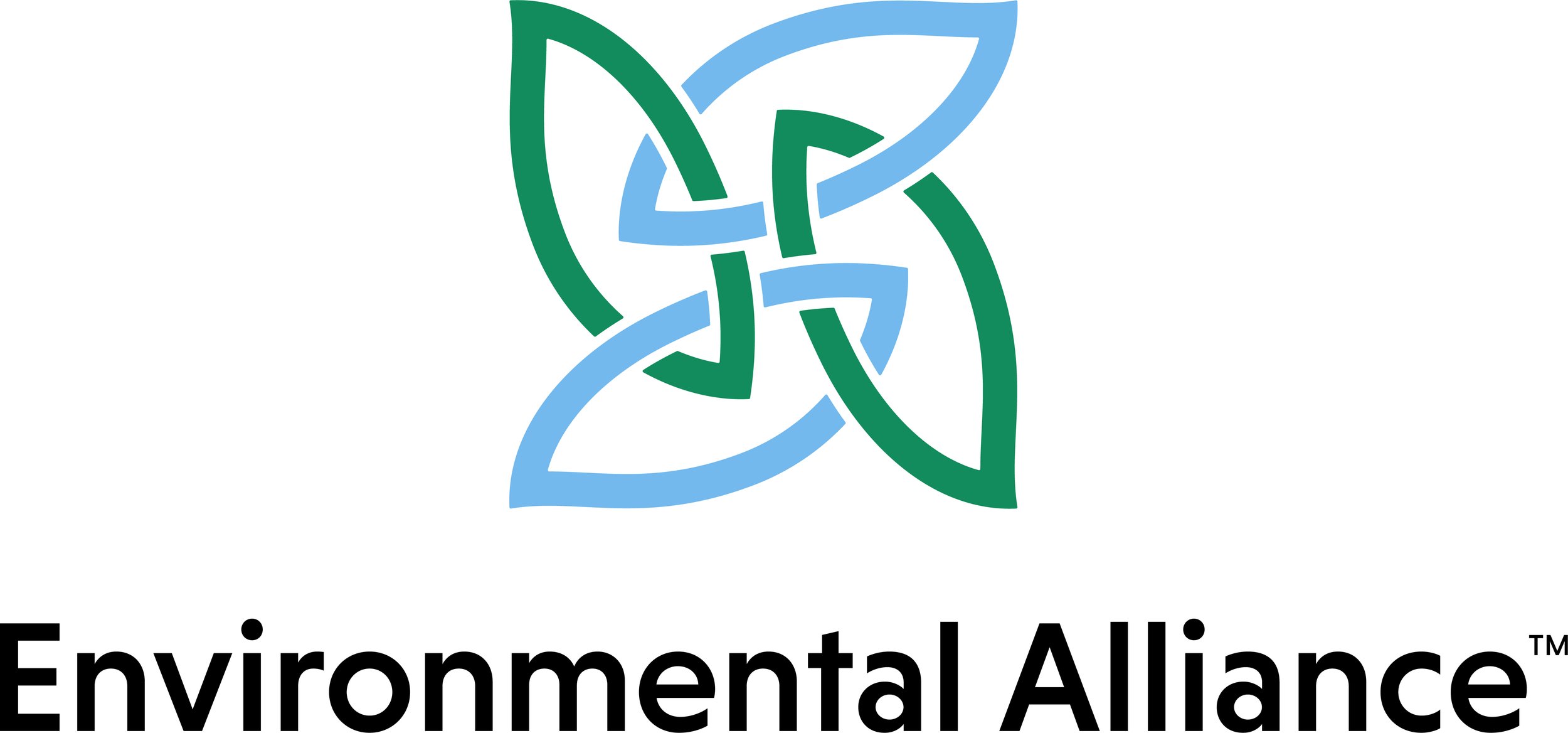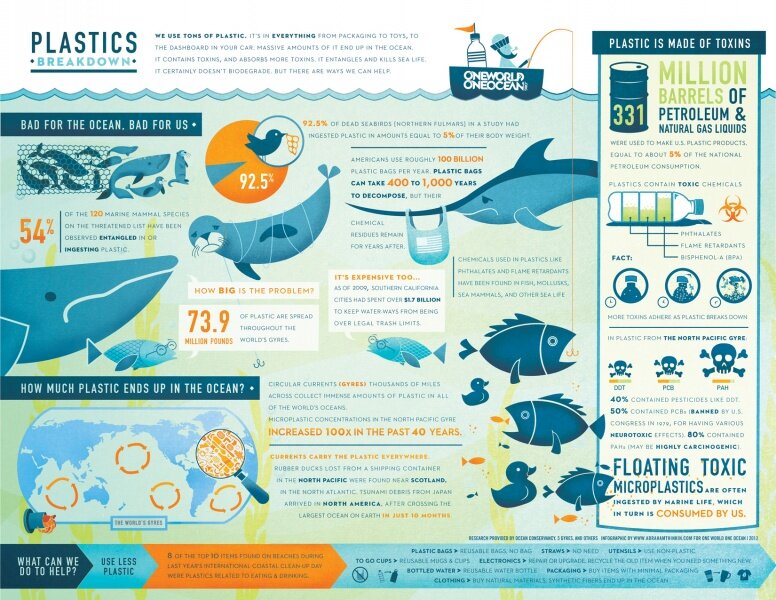On Land and in our Waters: the Pervasive Plastic Problem
Plastics are everywhere. Their invention was intended to be an environmentally friendly solution, in reality, plastics are an environmental nightmare. Plastics are a long-lived product filling a short term need, single-use plastics are just the tip of the iceberg.
Plastics are killing indiscriminately, animals are entangled, sea life ingests plastics, perishing from starvation or complications from bellies full of plastic. We are not immune, fish and shellfish are ingesting plastic and passing it up the food chain. Humans are at the top of that food chain. No one is quite sure what the implications are of plastics in our systems.
How did we become so dependent on plastics?
How are plastics getting in our waters and food chain?
What effect is plastic pollution having on our marine environment and on us?
Let’s find out.
Plastic Prototypes Touted as Environmentally Friendly
Ironically the invention of plastic began as an ecological endeavor to reduce ivory use. A billiard company in 1863 offered 10,000 dollars to the person who could invent a replacement for ivory billiard balls. John Wesley Hyatt created a precursor to plastic, a synthetic polymer made of cotton and nitric acid, he called celluloid. While not suitable for billiard balls, celluloid could be molded into different shapes ranging from canisters to piano keys, but was dangerous to make and highly flammable.
Leo Baekeland was credited with the invention of plastic in 1907. Looking for an alternative to shellac, he wanted a durable, heat resistant product with insulation properties. The coal tar-based product he called Bakelite became the first fully synthetic plastic. Bakelite paved the way for newer products – polystyrene, polyester, nylon, and PVC.
The production of cheap, durable products ramped up during the financially difficult WWII era. The lightweight, moldable material quickly became suitable for many products – packaging, containers, synthetic clothing fibers, car parts, and construction material, even microbeads sold in beauty products – the list is endless.
Today plastic products are part of everyday life - thin plastic bags and bottles holding everything from groceries, leftover food, and shampoo to toxic chemicals. Most products, food, clothing, home supplies are sold in plastics containers or are wrapped in plastic. The buildings we live in, cars we drive, and airplanes we fly have plastic parts.
Can you even think of one human-made product you bought recently that did not include some form of plastic?
Most plastics are made for a single use and are not reused or recycled. As of 2015, approximately 9% of plastics have been recycled and 12% incinerated.
This leaves 79% of the 6.3 billion metric tons of plastic waste collected in the natural environment and landfills. Multiple sources estimate that 91% of plastics are not recycled.
Beachapedia reported the U.S. produced over 126 billion plastic grocery bags in 2015. This averages 390 bags used per U.S. resident annually. We recycle less than 6% of these bags.
Infographic from Beachapedia.com
Plastic is a Long-Lived Product for Short Term Need
Plastic is a long-lived product used for many temporary solutions.
Plastic packaging accounts for 36% of plastic use. Most packaging has an average useful life of 6 months or under, although these plastic packages can survive for decades. The problem with long-lived plastics doesn’t stop with packaging.
We wash plastics down our drains daily. Microplastic particles from clothes, microbeads from shower gels, and cleaners end up in our sewage, but these particles are too small to be filtered out at treatment plants. These microbeads, eventually expelled from sewage plants, make their way into groundwater, streams, and rivers.
The Gulf of Mexico contains some of the highest concentrations of microplastics worldwide. Most of these microplastics are microfibers from land-based sources that flow from the Mississippi River basin into the gulf.
Microplastics from cosmetics that disappear down the drain unnoticed and synthetic fibers shed from clothes in washing machines end up in our oceans. The small size of these plastic pieces make them easy for the average consumer to overlook, or even be unaware of completely. Some of them are not even visible to the naked eye.
Plastic Pollution is Everywhere
Ocean currents distribute these microplastics to every corner of the world. The Arctic Ocean surface waters contain the most plastics of any ocean. The Arctic Ocean also has the highest concentrations of microplastics in deep marine sediments as of November 2018. Over two-third of plastic litter ends up on the seabed. The remaining plastic pollution is washed up on beaches or floats on or under the surface of our oceans, according to a report from the United Nations Environment Program (UNEP).
Plastics have reached remote islands, the deepest trenches, and are ingested by countless marine life species from the smallest corals and shellfish to the most massive whales. It is hard to fathom the plastics that wash down a drain in Chicago, or laundry washed in Denver home, or bottle forgotten on a California beach, could end up distributed on a faraway island or in the belly of a whale, but the dangers of plastics are far-reaching.
Mistaken for Food
Plastics were designed to withstand various pressures and not biodegrade quickly. However, plastics break down into smaller particles, making it even easier for plastics to travel far and wide and enter the food chain.
These floating microplastics are ingested by marine life. Seabirds like the petrel, albatross, and shearwaters, which spend most of their lives at sea, are now used as an indicator of plastic contamination.
Researchers find 80% of these birds have ingested some form of plastic. Starvation with their stomachs full of plastics is not the only cause of death. Since the ’60s, seabirds have been dying from bits of plastic blocking their digestive system and piercing their stomach and intestines. These birds are even bringing pieces of plastic back to feed their chicks, continuing this cycle of death.
Birds are by far not the only animals threatened by ingesting plastics. Sea turtles dine on delicate translucent sea creatures – Jellyfish. The problem is plastic bags, and grocery sacks floating in the ocean are mistaken for jellyfish.
Thirty-four percent of dead leatherback sea turtles are found with plastics in their digestive systems.
Why are these animals fooled into thinking plastic is food?
Researchers believe they have discovered the answer. Plankton and bacteria grow on plastics’ surface, making them smell and taste appealing to birds, turtles, and fish. Filter feeding animals like mussels and baleen whales unintentionally ingest plastic along with plankton.
Plastics in the Ocean Presents Multiple Problems
Plastics are making their way into our waters, being ingested by marine life, and accumulating in the food chain, resulting in poisoning and other health problems. Plastics have been shown to reduce the growth of some species. Common additives to plastics, including antimicrobial agents, antitoxins, and flame retardants, cause hormone production changes.
Chemicals that leach from plastic bags and other plastics are known to reduce Prochlorococcus’ growth, a marine bacteria responsible for one-tenth of the world’s oxygen production.
Some plastic particles absorb harmful chemicals and toxins from the environment, which bioaccumulate in the food chain and impact wildlife and humans' health. DDT and polychlorinated biphenyl PCB that can accumulate in plastics are known to cause immune system problems, liver damage, and childhood development issues.
Toxic Levels of Plastics
While some animals ingest plastics directly, other animals ingest the plastics hidden within their typical food. The indigestible plastics are transferred up the food chain from one predator to the next.
That means humans are at risk also. Studies typically find 8 to 11 pieces of microplastics in oysters, clams, and mussels. No one is sure how much plastic the average person consumes in a lifetime or what level is ‘safe.’
What’s Next?
Single use plastics are continuing to be produced. Are we willing to give up the convenience of plastics for the greater good?
We are fully aware plastics are being ingested and causing the death of thousands of animals on land and in our waters. Birds, turtles, and other marine creatures die from intestines ruptured by plastic pieces or starvation with stomachs full of plastic. It has been well documented that plastics absorb toxins and can contribute to health problems when they accumulate in the food chain. What effects plastics are having in our systems - no one is quite sure.
It’s time to take a stand, demanding companies invest in research that will replace plastic with environmentally friendly alternatives.
Photo Credit: Wildlife by Yuri





